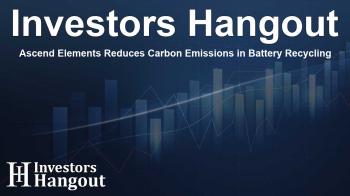Ascend Elements Reduces Carbon Emissions in Battery Recycling

Revolutionizing Battery Recycling with Lower Emissions
Ascend Elements has made significant strides in the field of battery recycling with its innovative Hydro-to-Cathode® pCAM process. A recent Life Cycle Assessment revealed striking results, demonstrating a 49% reduction in carbon dioxide equivalent (CO2e) emissions and a 26% decrease in particulate matter emissions compared to conventional recycling techniques.
Understanding the Impact of Hydro-to-Cathode® Technology
This pioneering process represents a pivotal leap in making battery recycling cleaner and more sustainable. Ascend Elements has set ambitious goals to further reduce CO2e emissions by 86% and particulate matter emissions by 94% by the year 2030. These targets will be achieved through various initiatives, including utilizing 100% renewable energy in their operations and implementing lower-carbon reagents in their production processes.
Future Goals and Commitments
As the demand for sustainable battery materials grows, Ascend Elements is committed to leading the charge. Their projections for the future include a substantial cut in emissions through advanced methodologies and infrastructure. With continuous improvements and strategic investments, the company aims to establish a greener footprint in the battery market.
Details of the Life Cycle Assessment Study
The recent Life Cycle Assessment was meticulously conducted following standardized ISO protocols, ensuring rigorous evaluation and accuracy. Expert reviewers from diverse fields evaluated the methodology and findings, affirming the credibility of the results. Eric Gratz, Ph.D., Co-founder and CTO at Ascend Elements, emphasized the importance of efficiency and emissions reduction throughout the design of their processing techniques.
Emissions Comparison with Traditional Methods
When analyzing the emissions associated with lithium carbonate production, the study showed that producing 1 kilogram of lithium carbonate emits merely 2.3 kg CO2e—significantly less than the 16.8 kg CO2e associated with spodumene mining and the 3.6 kg CO2e from brine extraction. This highlights Ascend Elements’ effective reduction before reaching their ultimate goal of just 0.2 kg CO2e per kg of lithium carbonate by 2030.
A Focus on Particulate Matter Emissions
Particulate matter emissions from Ascend Elements' innovative lithium recovery techniques are also markedly lower. According to the assessment, their lithium carbonate product contributes 97% less pollution compared to spodumene mining and 81% less compared to brine extraction. Their ambitious plans include achieving a staggering 99.7% reduction in PM emissions by 2030 compared to existing extraction methodologies.
Scaling Operations and Facilities
Ascend Elements is actively expanding its operational capabilities. One of North America's largest battery recycling facilities is located in Covington, Georgia, where a new lithium recovery line is projected to yield up to 3,000 metric tons of lithium carbonate annually. Furthermore, the company is developing a state-of-the-art Hydro-to-Cathode® pCAM manufacturing facility in Hopkinsville, Kentucky, aiming to support the production of battery materials for up to 750,000 electric vehicles each year.
About Ascend Elements
Founded in 2015, Ascend Elements is at the forefront of providing critical minerals and advanced battery materials specifically tailored for the lithium-ion battery industry. The company's Hydro-to-Cathode® technology allows them to produce new cathode material from recycled battery materials more efficiently than traditional techniques. This innovative approach not only enhances economic viability but also substantially lowers carbon emissions—reflecting Ascend Elements’ commitment to sustainability.
Frequently Asked Questions
What is the Hydro-to-Cathode® process?
The Hydro-to-Cathode® process is an innovative method developed by Ascend Elements to synthesize battery materials directly from recycled batteries, significantly reducing emissions compared to traditional methods.
How much do CO2 emissions decrease with the new technology?
The process has achieved a reduction of 49% in CO2 emissions and aims for further reductions by 2030 through various sustainability initiatives.
How does this process affect lithium recovery?
The Hydro-to-Cathode® process produces lithium carbonate with substantially lower emissions—only 2.3 kg of CO2e per kg produced, making it significantly more sustainable than conventional lithium extraction methods.
Where are Ascend Elements’ facilities located?
Ascend Elements has major facilities in Covington, Georgia, for battery recycling and is establishing a new lithium manufacturing facility in Hopkinsville, Kentucky.
What are the long-term goals of Ascend Elements?
Ascend Elements aims to drastically lower emissions from battery production and recycling while expanding its ability to produce sustainable battery materials to meet the rising demand for electric vehicles.
About The Author
Contact Ryan Hughes privately here. Or send an email with ATTN: Ryan Hughes as the subject to contact@investorshangout.com.
About Investors Hangout
Investors Hangout is a leading online stock forum for financial discussion and learning, offering a wide range of free tools and resources. It draws in traders of all levels, who exchange market knowledge, investigate trading tactics, and keep an eye on industry developments in real time. Featuring financial articles, stock message boards, quotes, charts, company profiles, and live news updates. Through cooperative learning and a wealth of informational resources, it helps users from novices creating their first portfolios to experts honing their techniques. Join Investors Hangout today: https://investorshangout.com/
The content of this article is based on factual, publicly available information and does not represent legal, financial, or investment advice. Investors Hangout does not offer financial advice, and the author is not a licensed financial advisor. Consult a qualified advisor before making any financial or investment decisions based on this article. This article should not be considered advice to purchase, sell, or hold any securities or other investments. If any of the material provided here is inaccurate, please contact us for corrections.

